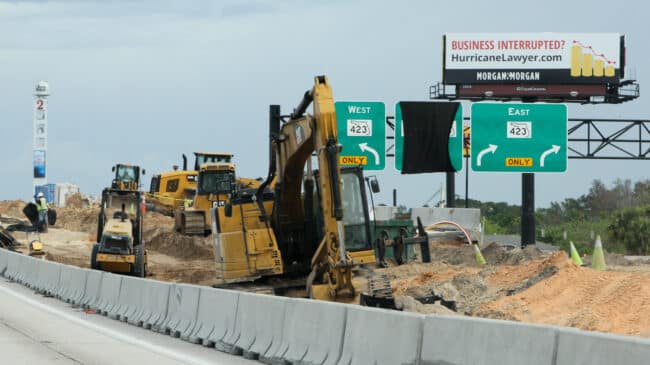In one of my previous columns for Public Works Financing, I suggested that by far the largest U.S. public-private partnership (P3) opportunity would be revenue-risk design-build-finance-operate-maintain (DBFOM) projects to rebuild America’s aging Interstate highways via toll financing. The cost of reconstruction and selective widening of Interstates was estimated to be approximately $1 trillion over the next 20 years by a major Transportation Research Board study.
Unfortunately, neither the $1.2 trillion bipartisan infrastructure bill, the Infrastructure Investment and Jobs Act (IIJA), signed by President Joe Biden, nor the still-being-debated $2 trillion Build Back Better bill proposal makes any provision for rebuilding this country’s most valuable highway infrastructure. In order to have a growing economy in the decades ahead, the country’s aging Interstates must be modernized. And if Congress ignores this need, the Interstate system’s owners—the 50 states—need to pick up the ball, if only to maintain their own economic competitiveness.
Toll financing is feasible for all but a handful of state Interstate systems, as a number of studies have demonstrated. And starting the national shift from per-gallon fuel taxes to per-mile charges would be easiest to do on limited-access highways where all-electronic tolling with E-ZPass-style transponders is generally well-accepted.
The obstacles to these changes are neither financial nor technological. The primary obstacle is political opposition to tolling. Highway user groups, having been stung by large-scale toll revenue diversion in some northeastern states, have tended to oppose any expansion of tolling. The trucking industry, in particular, objects to “double taxation” and toll roads as “cash cows,” and those are justified concerns.
About a decade ago, after several years of dialog with senior people at both AAA and the American Trucking Associations, I drafted customer-friendly tolling provisions addressing those two objections and also positing that tolling should not begin in a corridor until the reconstruction/widening had been completed—you pay for delivered benefits, not for a vague future promise of same. The national board of AAA endorsed those provisions in 2015.
The trucking industry already gets rebates of transportation user taxes associated with miles driven on the New York Thruway and the Massachusetts Turnpike. Companies that use Bestpass to handle their tolling accounts have the rebates taken care of as part of that service. So we already know that this would also be doable for newly tolled corridors, such as toll-financed rebuilt Interstates.
But with fuel tax revenue entering what will soon be understood as a decades-long decline, would any state transportation department agree to provide fuel-tax rebates to motorists and truckers using toll-financed Interstates? I’d expect the answer to be no, but a new Reason Foundation policy brief may lead to a different answer.
With some assistance from a noted traffic and revenue consultant, I built a spreadsheet model of a generic mid-size state using toll finance to rebuild its four long-distance (rural) Interstates, two of which were assumed to need widening. The model used toll rates comparable to those charged to light and heavy vehicles on tolled Interstates and construction costs drawn from the Federal Highway Administration’s Highway Economic Requirements System (HERS) database. Reconstruction of the first corridor was modeled as beginning in 2025 and opening with tolls in 2030, with the other three projects occurring in subsequent years. The toll rates were shown as being capable of covering both capital and operation and maintenance costs over the years from 2025 through 2060.
The tricky part was calculating the fuel tax rebate amounts. This required projections of fleetwide fuel economy (miles per gallon, mpg) through 2060 and projections of electric vehicle penetration into both the light vehicle and heavy vehicle fleet. These projections made it possible to calculate the amount of fuel used, fuel taxes incurred, and rebate amounts (which of course would go only to petroleum-fueled vehicles). The final comparison showed that the net present value of fuel-tax rebates over that time period was less than 7% of the net present value of toll revenues.
These results should allay concerns of state departments of transportation (DOTs) about giving up a portion of their decreasing fuel tax revenue, starting in 2030. That’s because by opting to use toll financing to modernize their Interstates, they will avoid both the many billions of dollars in capital costs and the ongoing operation and maintenance costs for those corridors, which would be fully covered by the toll revenues. Therefore, they could devote the remaining 93% of their fuel tax revenue to all the other roadways for which they are responsible.
Will this be enough to persuade the trucking industry?
The study deliberately assumed toll rates high enough to cover the full costs of rebuilding and modernizing the Interstates, but a state would need to provide statutory protection for those revenues to avoid the “tolls as cash cows” problem. The model also showed tolling not beginning until each corridor was completed and opened to traffic—a key point in the value proposition. And of course it eliminated the double-taxation concern by providing fuel-tax rebates.
For several decades the trucking industry has proclaimed its willingness to pay more, in order to modernize the Interstate corridors on which it is highly dependent. Congress has failed to deliver any program to rebuild and modernize the Interstates. At this point, I think it’s time to suggest to the trucking industry that customer-friendly tolling is their least-bad alternative—and perhaps the only feasible alternative for getting the second-generation Interstates that they need. The public-private partnership community and state transportation departments should engage the trucking industry with this approach.
A version of this column originally appeared in Public Works Financing.

